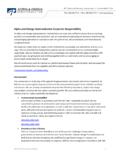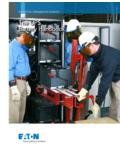Transcription of Power Semiconductor Reliability Handbook
1 2010 Alpha and Omega Semiconductor Rev. 5/20/10 Power Semiconductor Reliability Handbook Alpha and Omega Semiconductor 475 Oakmead Pkwy Sunnyvale, CA 94085 Power Semiconductor Reliability Handbook 2010 Alpha and Omega Semiconductor Rev. 5/20/10 2 Table of Contents 1 The AOS Reliability Design-in of Technology Development ..3 Qualification and Product Development ..3 Mass Customer Feedback and Failure Analysis ..4 Continuous Improvement ..4 2 Fundamentals of Reliability ..5 Definition of Bathtub Curve.
2 5 Infant-Mortality Random-Failure Region ..6 Wear-Out Region ..6 3 Reliability Test Methods ..7 Accelerated Life Temperature Acceleration ..8 Activation Voltage Acceleration ..9 Temperature-Cycle Humidity Acceleration ..10 4 Reliability Function for Data Analysis ..11 Definition of Reliability Function ..11 Failure Distribution Function ..11 Failure Probability Density Function ..12 Failure-Rate Function (Hazard Function) ..12 Unit for Failure Rate ..13 Application of Different Probability Exponential Distribution ..13 Simple-Failure-Rate Calculation.
3 14 Weibull Log-Normal Application of Log-Normal 5 Technology Stress Tests ..19 Hot-Carrier Lifetime ..19 Time-Dependent Dielectric Breakdown (TDDB) ..21 6 Product Stress Tests for Qualification ..22 High-Temperature Life Tests ..22 High-Temperature Gate Bias (HTGB) ..22 High-Temperature Reverse Bias (HTRB) ..22 High-Temperature Operating Life (HTOL) ..22 Environmental Precondition (Accounting for the Popcorn Effect)..22 High-Temperature Storage (HTS) ..23 Temperature Cycling (TC) ..23 Temperature Humidity Bias (THB)..23 Highly Accelerated Stress Test (HAST).
4 23 Pressure-Cooker Test (PCT)..23 Intermittent Operational Life (IOL) ..23 Power Semiconductor Reliability Handbook 2010 Alpha and Omega Semiconductor Rev. 5/20/10 3 1 The AOS Reliability Program In a Power device application, high Power is usually encountered. AOS strives to make Power devices reliable for their intended application. In order to achieve this goal, the Reliability activities are spread throughout all phases of a product s lifetime. Design-in of Reliability During the design phase, especially when a new platform for new technology is involved, thorough calculations and simulations are carried out to ensure the designed electrical parameters and other Reliability characteristics are optimized.
5 For example, when the breakdown voltage needs to be changed, the simulation involves all the structure changes to optimize the breakdown voltage, threshold voltage, channel resistance, various parasitic capacitances, and the trade-off with UIS robustness, etc. For a new package design, thermal resistance is very important. A thorough simulation using 3-D finite element analysis has to be carried out. Technology Development Once a design is done and reviewed by the cross-functional team, new silicon wafers and packages need to be built to verify the design. Based on the design and simulations, a thorough design of experiment (DOE) needs to be designed.
6 Split runs and some unit process experiments need to be carried out. Electrical and physical analyses need to be performed. Then, the best leg of the DOE is chosen as the baseline process. During this period of development, some of the device or test structures are chosen, either in the wafer-level form or the final package form, to do the Reliability stress test to verify the robustness of the new technology. This initial Reliability evaluation helps to further improve the design and process technology, if any weakness is found. If some fundamental process modules or new devices need to be studied, quite often some specially designed test structures have to be run through the process and get characterized ( , hot-carrier lifetime, electromigration, and oxide integrity, etc.)
7 Qualification and Product Development During this phase of development, the wafer process and package technology are defined and frozen. A product vehicle for qualification needs to be chosen. A formal qualification plan is generated. Full qualification tests need to be carried out, including life tests and environmental tests. The lot requirement and sample size have to follow an industry standard such as JEDEC (JESD47D). The qualification lot has to be run by production personnel without special attention or treatment, in order to reflect the true manufacturing process in the future.
8 Pre-production Once the formal qualification is done on the frozen process and it passes all the stress tests, a larger quantity of the device is run to check the manufacturing process. Yield and some of the Reliability monitoring data are reviewed closely to ensure there is no mass-production problem. During this period of time, an initial production management program may need to be implemented, such as increasing sample size for in-line process monitoring. A Reliability monitoring program and even some Reliability screening programs need to be installed to ensure the product is reliable.
9 Mass Production A formal monitoring program needs to be implemented during the lifetime of the product to ensure the Reliability of the product remains the same. Requalification has to be done if any material or process changes that will impact the form and fit or quality and Reliability . Customers will be informed of major changes to ensure there is no problem with their system production. Power Semiconductor Reliability Handbook 2010 Alpha and Omega Semiconductor Rev. 5/20/10 4 Customer Feedback and Failure Analysis AOS provides customers with reliable product throughout the lifetime they use the device in their system.
10 During the design-in period for the system, if any issue occurs, AOS dispatches a field application engineer (FAE) and system application engineer (AE) to work with customers to solve the problem. Quite often, the problem is an application issue that can be solved by changing to a part with the right electrical parameters, slightly changing the system circuit topology, or using different values for some of the peripheral components. If the problem identified belongs to the manufacturing of the parts, AOS will implement corrective action to prevent future recurrences. If a customer encounters device malfunction during their system production or from field failure, this is a very serious matter to AOS.
















